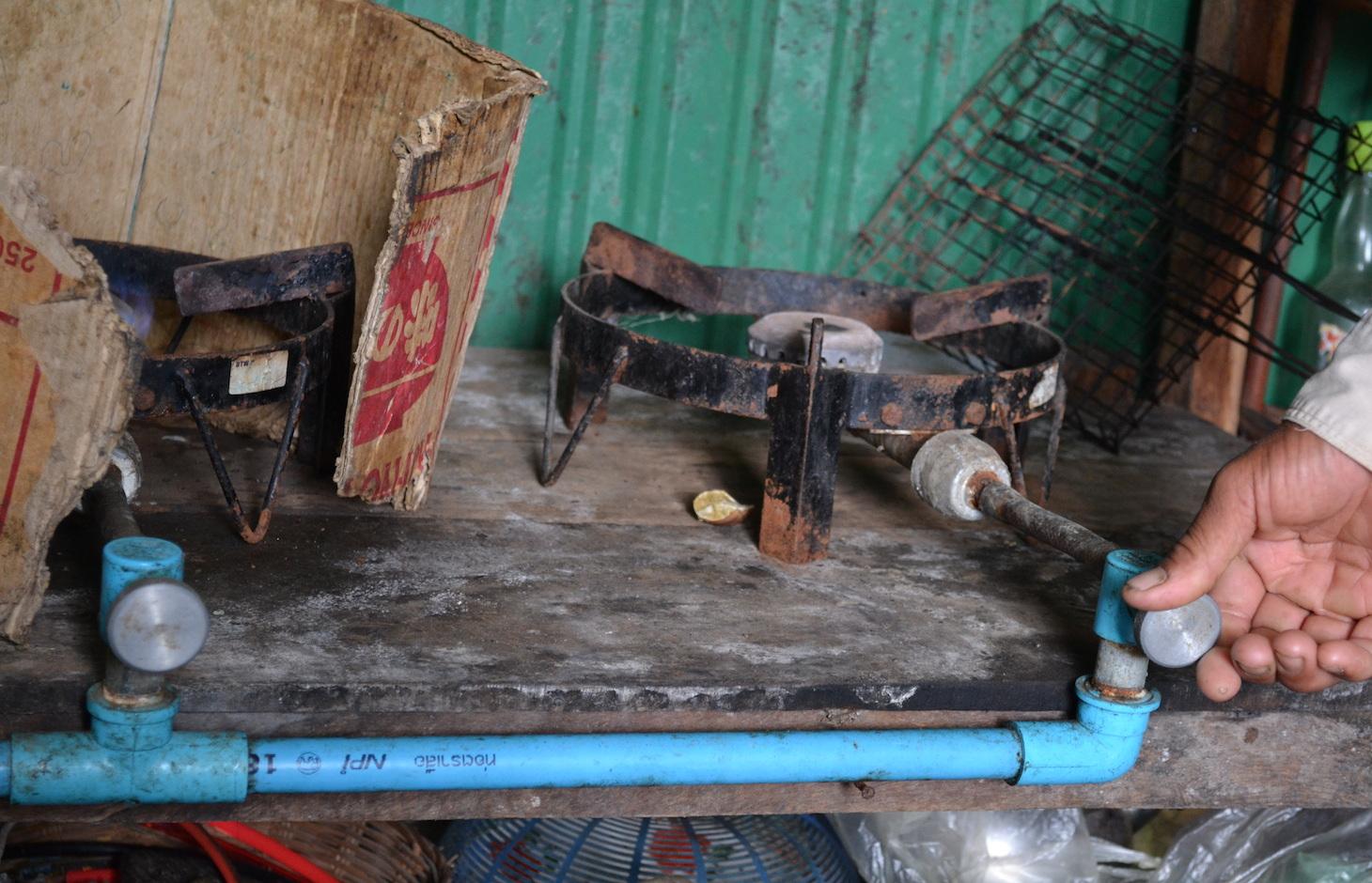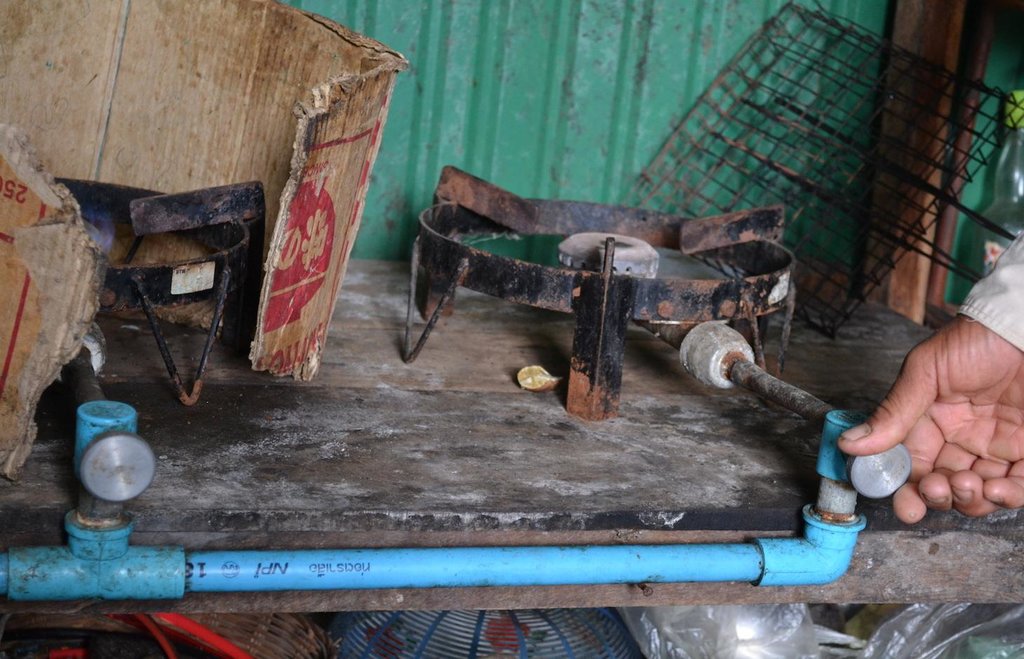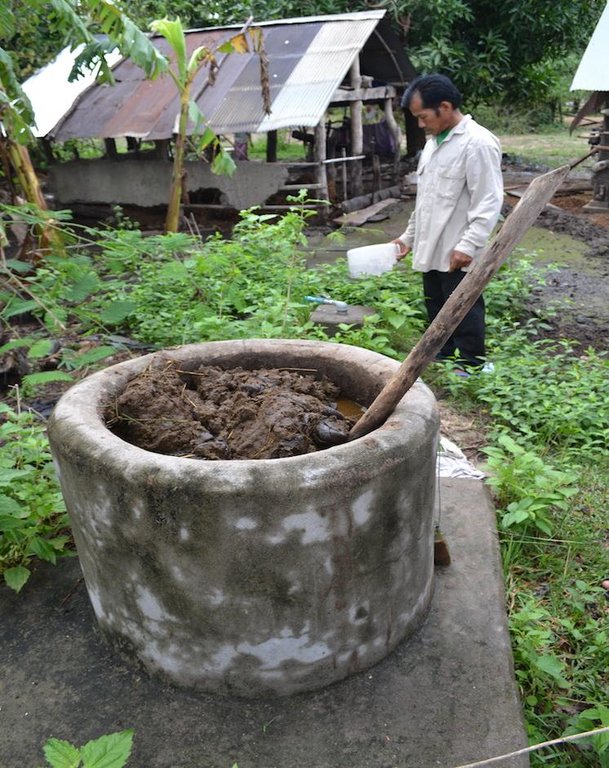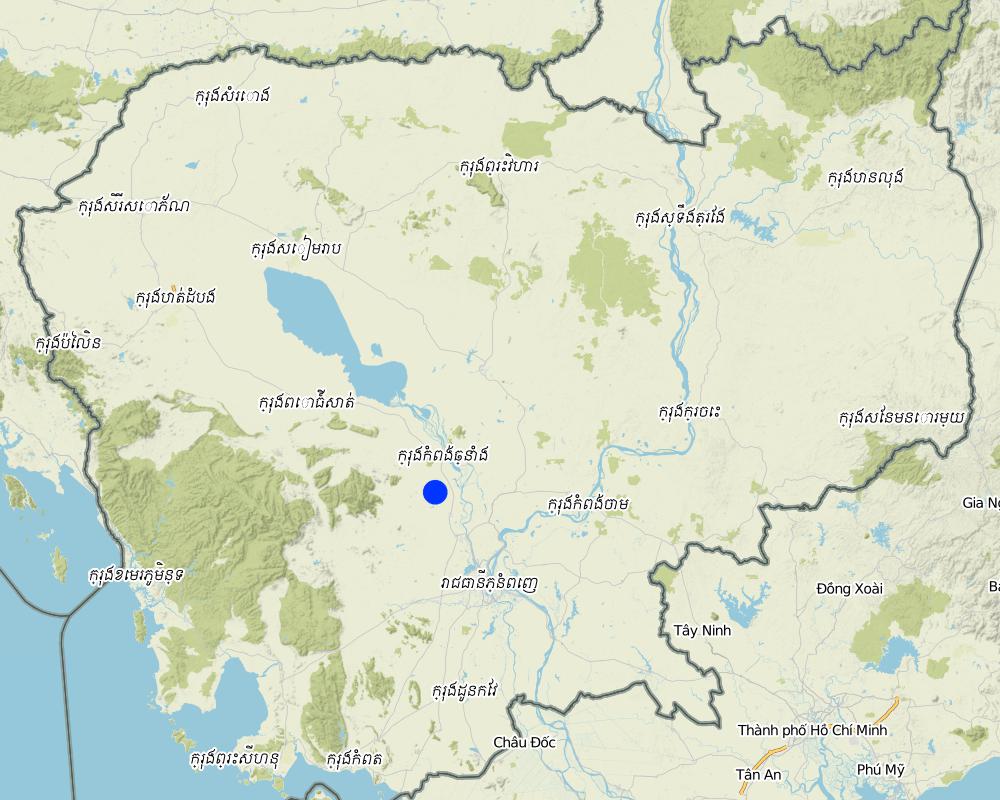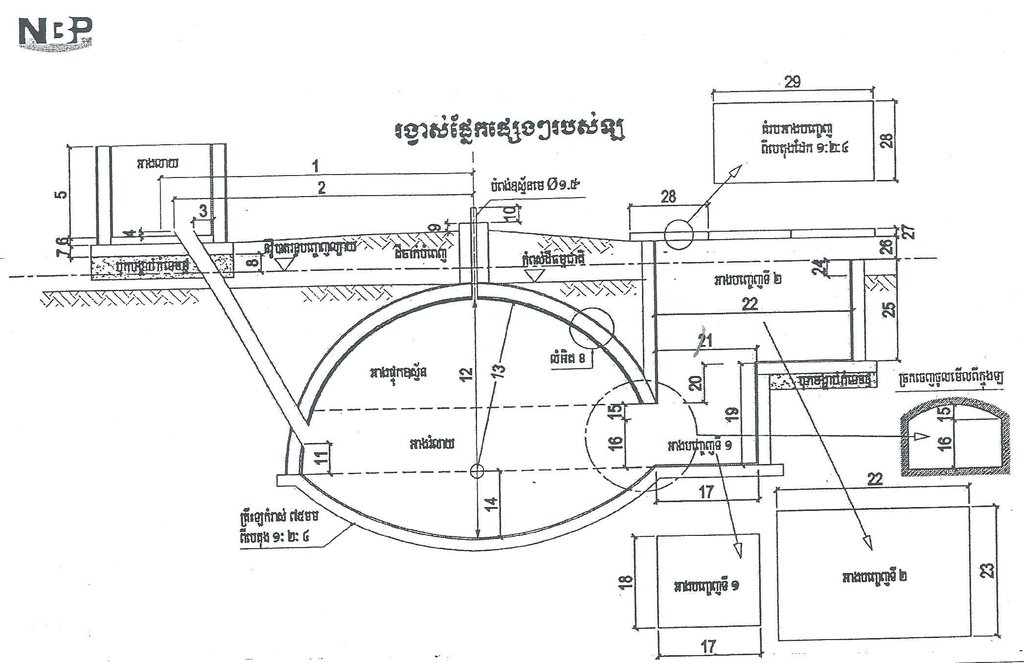Biogas system at household level fed daily with cattle manure [Cambodia]
- Creación:
- Actualización:
- Compilador: Christoph Kaufmann
- Editor: –
- Revisores: Deborah Niggli, David Streiff, Alexandra Gavilano
ប្រពន្ធ័ឡជីវៈឧស្ម័នប្រើសំរាប់គ្រួសារប្រចំាថៃ្ងដោយប្រើលាមកគោ (Khmer)
technologies_1645 - Cambodia
Visualizar secciones
Expandir todo Colapsar todos1. Información general
1.2 Detalles de contacto de las personas de referencia e instituciones involucradas en la evaluación y la documentación de la Tecnología
Especialista MST:
Khun Lean Hak
SOFDEC/LAREC, www.sofdec.org
Cambodia
Especialista MST:
Pith Khonhel
LAREC
Cambodia
Especialista MST:
Bin Sreytouch
SOFDEC
Cambodia
Especialista MST:
Say Mesa
SOFDEC
Cambodia
Nombre de la(s) institución(es) que facilitaron la documentación/ evaluación de la Tecnología (si fuera relevante)
Society for Community Development in Cambodia (SOFDEC) - CambodiaNombre de la(s) institución(es) que facilitaron la documentación/ evaluación de la Tecnología (si fuera relevante)
Local Agricultural Research and Extension Centre (LAREC) - Cambodia1.3 Condiciones referidas al uso de datos documentados mediante WOCAT
El compilador y la/s persona(s) de referencia claves aceptan las condiciones acerca del uso de los datos documentados mediante WOCAT:
Sí
1.4 Declaración de la sostenibilidad de la Tecnología descrita
¿La Tecnología aquí descrita resulta problemática en relación a la degradación de la tierra, de tal forma que no puede considerársela una tecnología sostenible para el manejo de la tierra?
No
2. Descripción de la Tecnología MST
2.1 Breve descripción de la Tecnología
Definición de la Tecnología:
Small-scale biogas systems fed with cow manure and water are implemented in order to supply the household with energy for cooking and lighting, as well as to produce fertilizer.
2.2 Descripción detallada de la Tecnología
Descripción:
In this case-study, a small-scale biogas system was introduced in order to generate both energy for home consumption and fertilizer. Small-scale biogas systems are implemented in different parts of the world, however the layout thereof varies considerably.
The model used in this case-study consists of different components (cf. technical drawing). First, there is an inlet where the land user puts cow manure mixed with water. On the bottom of the inlet, there is a board which closes the access to the bio-digester situated beneath the inlet. The board can be opened manually by pulling a string. Once the board is open, the fluid components go through a pipe which leads to the bio-digester. In the bio-digester, bacteria transform the organic matter into biogas (mainly methane and CO2) and slurry. At the other end of the digester, there is another pipe (outlet). The outlet is lower than the inlet, and due to the difference in pressure, the slurry is pushed out of the digester. The slurry is dried and applied to the fields two to three times a year with the help of an ox cart. It has similar effects on the plant growth as chemical fertilizer as it does not build up the soil organic matter as much as compost. The biogas, however, is pushed to the pipe situated on top of the digester and can be utilized for domestic uses. The gas is used for cooking and lighting.
The use of biogas allows reducing the expenses on charging batteries for the lighting, as well as reducing the firewood use (usually from deforestation) for cooking. The slurry reduces the expenses on chemical fertilizer in the fields and has the advantage of killing the weed and rice seeds present in the manure and crop residues.
For building the biogas system, there is governmental and NGO support. These two actors finance half of the construction costs. The other half is paid by the land user. Building a biogas system is quite costly, with about 400 $, and not all of the land users in the area can afford paying 50% of its price. However, the costs borne by the land user are paid off within a few years due to reduced expenses on firewood, chemical fertilizer, and charging batteries. The construction itself was undertaken by local companies.
The costs are paid off within a few years due to the reduced expenses on firewood, chemical fertilizer and battery charging.
The analysed area is flat (slope < 2%), tropic (dry and wet season), and the soils are mostly sandy or loamy. The soils contain little organic matter (low soil fertility, acidification, small amount of cattle, area has been deforested a long time ago) and the groundwater table is rather high (1-3 m during the dry season, on the surface during wet season).
Due to climate change, the rainfalls are more erratic, temperatures rise and droughts are more recurrent. Rice is the predominant crop grown in the area, since it serves as staple food (mix subsistence and commercial activities). Rice is often grown in monocultures and harvested once a year. Once the rice is harvested (dry season), the cattle are released to the paddy fields. The cattle is often replaced by hand tractors, which effects the production of manure but allows a higher amount of crop residues on the fields.
As an addition to rice, most land users grow vegetable and fruits in small home gardens (subsistence) and complement their income by producing handicrafts or through off farm income / remittances from family members working in other places. The increasing migration rate (the young generation leaves the villages to work in the cities, garment industry or abroad) results in a decrease of available labour force in the area which has detrimental effects on the agricultural activities. Furthermore, the civil war in the 1970s (Khmer Rouge) led to the loss of agricultural knowledge which different NGOs try to re-establish.
2.3 Fotografías de la Tecnología
2.5 País/ región/ lugares donde la Tecnología fue aplicada y que se hallan comprendidos por esta evaluación
País:
Cambodia
Región/ Estado/ Provincia:
Kampong Chhnang
Especifique más el lugar :
Sre Ouk Samlor Sap/Taing Krasaing/Rolear Pha,er
Especifique la difusión de la Tecnología:
- distribuida parejamente sobre un área
Si se desconoce el área precisa, indique el área aproximada cubierta:
- 0.1-1 km2
Comentarios:
There are only 4 households in this village which apply the technology (lack of money and/or cattle). However, similar Technologies are introduced in other provinces – yet it is difficult to estimate the area covered. Estimation for this village.
Map
×2.6 Fecha de la implementación
Si no se conoce el año preciso, indique la fecha aproximada:
- hace menos de 10 años (recientemente)
2.7 Introducción de la Tecnología
Especifique cómo se introdujo la Tecnología:
- mediante proyectos/ intervenciones externas
Comentarios (tipo de proyecto, etc.):
LWS (a Dutch NGO) in joint efforts with specialists from the National Biodigester Program NBP. Implementation in 2012
3. Clasificación de la Tecnología MST
3.1 Propósito(s) principal(es) de la Tecnología MST
- mejorar la producción
- crear impacto económico benéfico
3.2 Tipo(s) actuales de uso de la tierra donde se aplica la Tecnología

Tierras cultivadas
- Cosecha anual
Número de temporadas de cultivo por año:
- 1
Especifique:
Longest growing period in days: 210, Longest growing period from month to month: June-December

asentamientos, infraestructura
- Asentamientos, edificios
- biogas system
Comentarios:
Major land use problems (compiler’s opinion): Lack of organic matter, lack of water retention in soil, irregularity of rainfall, low soil fertility (sandy soil), monocultures, bare soil during dry season, ploughing.
Major land use problems (land users’ perception): Low soil fertility, lack of water.
Livestock is grazing on crop residues
Constraints of settlement / urban
Constraints of infrastructure network (roads, railways, pipe lines, power lines)
3.5 Grupo MST al que pertenece la Tecnología
- tecnologías de eficiencia energética
3.6 Medidas MST que componen la Tecnología

medidas estructurales
- S11: Otros

medidas de manejo
- M6: Manejo de desperdicios (reciclado, reutilización o reducción)
Comentarios:
Main measures: management measures
Secondary measures: structural measures
3.7 Principales tipos de degradación del suelo encarados con la Tecnología

deterioro químico del suelo
- Cn: reducción de la fertilidad y contenido reducido de la materia orgánica del suelo (no ocasionados por la erosión)
- Ca: acidificación

degradación biológica
- Bs: reducción en la calidad y composición/ diversidad de las especies
Comentarios:
Main causes of degradation: soil management (Ploughing, soil is left bare for several weeks), crop management (annual, perennial, tree/shrub) (Rice monoculture (rice as staple crop)), change of seasonal rainfall (More erratic beginning of wet season), droughts (On dry soil, rice cannot be planted and if already planted, rice cannot grow), labour availability (High migration rates from the villages to garment industry, cities or abroad, influence agricultural activities (e.g. broadcasting instead of transplanting of rice seedlings)), education, access to knowledge and support services (Khmer Rouge regime in the 1970s, a lot of knowledge got lost)
Secondary causes of degradation: over-exploitation of vegetation for domestic use (Rice straw is removed for different domestic uses (cattle, mushroom cultivation, etc.)), overgrazing (Cattle eats rice straw left after harvest, less organic matter on the field, grazing is not managed), change in temperature (More hot days), Heavy / extreme rainfall (intensity/amounts), land tenure (Some incidents of land grabbing, land use rights not clear, corruption), poverty / wealth
3.8 Prevención, reducción o restauración de la degradación del suelo
Especifique la meta de la Tecnología con relación a la degradación de la tierra:
- prevenir la degradación del suelo
- reducir la degradación del suelo
4. Especificaciones técnicas, actividades de implementación, insumos y costos
4.1 Dibujo técnico de la Tecnología
Especificaciones técnicas (relacionadas al dibujo técnico):
Biodigester. Inlet: top left; gas outlet: top centre; digestion chambre: centre; and outlet: right. For the comlete building instructions contact the NBP.
Technical knowledge required for field staff / advisors: high (The most challenging part is the construction of the construction of the Biodigester.)
Technical knowledge required for land users: low
Main technical functions: increase in nutrient availability (supply, recycling,…)
Secondary technical functions: increase in organic matter
Structural measure: Biodigester. Round shape. Tiles and concrete.
Width of ditches/pits/dams (m): 4 m^3
Structural measure: Connecting pipes made of plastic
Construction material (concrete): Tiles are covered in concrete.
Construction material (other): The most challenging part is the construction of the Biodigester.
Other type of management: Change of energy supply system for home consumption.
Autor:
National Biodigester Programm, www.nbp.org.kh
4.2 Información general sobre el cálculo de insumos y costos
otra / moneda nacional (especifique):
Riel
Si fuera relevante, indique la tasa de cambio de dólares americanos a la moneda local (ej. 1 U$ = 79.9 Reales Brasileros): 1 U$ =:
4000,0
Indique el costo promedio del salario de trabajo contratado por día:
5.00
4.3 Actividades de establecimiento
| Actividad | Momento (estación) | |
|---|---|---|
| 1. | Construction of the biodigester by external experts. The land user did not help with the construction, he only paid 200 US$. The other 200 US$ were paid by the National Biodigester Program. | Dry season, when water table is low. |
4.4 Costos e insumos necesarios para el establecimiento
| Especifique insumo | Unidad | Cantidad | Costos por unidad | Costos totales por insumo | % de los costos cubiertos por los usuarios de las tierras | |
|---|---|---|---|---|---|---|
| Material de construcción | Construction of biodigester | 1,0 | 400,0 | 400,0 | 50,0 | |
| Costos totales para establecer la Tecnología | 400,0 | |||||
| Costos totales para establecer la Tecnología en USD | 0,1 | |||||
4.5 Actividades de establecimiento/ recurrentes
| Actividad | Momento/ frequencia | |
|---|---|---|
| 1. | Add manure and water to the inlet | once per day all year round |
| 2. | Collect residuals from biodigester, spread it out and let it dry, and finally put it on the field. | 3 times/year |
4.6 Costos e insumos necesarios para actividades de mantenimiento/ recurrentes (por año)
| Especifique insumo | Unidad | Cantidad | Costos por unidad | Costos totales por insumo | % de los costos cubiertos por los usuarios de las tierras | |
|---|---|---|---|---|---|---|
| Mano de obra | Labour | 1,0 | 121,5 | 121,5 | 100,0 | |
| Indique los costos totales para mantenecer la Tecnología | 121,5 | |||||
| Costos totales para mantener la Tecnología en USD | 0,03 | |||||
Comentarios:
Machinery/ tools: Cart to bring residues from the biodigester onto the fields.
The costs were calculated for 1 biodigester with a capacity of 4 m3.
4.7 Factores más determinantes que afectan los costos:
Describa los factores más determinantes que afectan los costos:
The most costly part of this Technology is the construction of the biodigester. Once the system is installed, the costs borne by the land user are low. Also, the land user can save money since he doesn’t need to buy firewood any more.
5. Entorno natural y humano
5.1 Clima
Lluvia anual
- < 250 mm
- 251-500 mm
- 501-750 mm
- 751-1,000 mm
- 1,001-1,500 mm
- 1,501-2,000 mm
- 2,001-3,000 mm
- 3,001-4,000 mm
- > 4,000 mm
Especificaciones/ comentarios sobre la cantidad de lluvia:
1486.45 mm 2013 in Kampong Chhnang
Zona agroclimática
- Sub-húmeda
27° to 35°C, 1486.45 mm 2013 in Kampong Chhnang
5.2 Topografía
Pendientes en promedio:
- plana (0-2 %)
- ligera (3-5%)
- moderada (6-10%)
- ondulada (11-15%)
- accidentada (16-30%)
- empinada (31-60%)
- muy empinada (>60%)
Formaciones telúricas:
- meseta/ planicies
- cordilleras
- laderas montañosas
- laderas de cerro
- pies de monte
- fondo del valle
Zona altitudinal:
- 0-100 m s.n.m.
- 101-500 m s.n.m.
- 501-1,000 m s.n.m
- 1,001-1,500 m s.n.m
- 1,501-2,000 m s.n.m
- 2,001-2,500 m s.n.m
- 2,501-3,000 m s.n.m
- 3,001-4,000 m s.n.m
- > 4,000 m s.n.m
5.3 Suelos
Profundidad promedio del suelo:
- muy superficial (0-20 cm)
- superficial (21-50 cm)
- moderadamente profunda (51-80 cm)
- profunda (81-120 cm)
- muy profunda (>120 cm)
Textura del suelo (capa arable):
- áspera/ ligera (arenosa)
- mediana (limosa)
Materia orgánica de capa arable:
- media (1-3%)
- baja (<1%)
5.4 Disponibilidad y calidad de agua
Agua subterránea:
< 5 m
Disponibilidad de aguas superficiales:
pobre/ ninguna
Calidad de agua (sin tratar):
agua potable de mala calidad (requiere tratamiento)
Comentarios y especificaciones adicionales sobre calidad y cantidad de agua:
Ground water tabel and availability of surface water data during dry seasons. People use water for drinking after filtering or boiling.
5.5 Biodiversidad
Diversidad de especies:
- baja
Comentarios y especificaciones adicionales sobre biodiversidad:
Only degraded forests are in the area.
5.6 Las características de los usuarios de la tierra que aplican la Tecnología
Sedentario o nómada:
- Semi-nómada
Orientación del mercado del sistema de producción:
- mixta (subsistencia/ comercial)
Ingresos no agrarios:
- 10-50% de todo el ingreso
Nivel relativo de riqueza:
- rico
Individuos o grupos:
- individual/ doméstico
Género:
- mujeres
- hombres
Indique otras características relevantes de los usuarios de las tierras:
Land users applying the Technology are mainly Leaders / privileged
Population density: 10-50 persons/km2
Annual population growth: 0.5% - 1%
Off-farm income specification: Handicraft, remittances and factory work.
5.7 Área promedio de la tierra usada por usuarios de tierra que aplican la Tecnología
- < 0.5 ha
- 0.5-1 ha
- 1-2 ha
- 2-5 ha
- 5-15 ha
- 15-50 ha
- 50-100 ha
- 100-500 ha
- 500-1,000 ha
- 1,000-10,000 ha
- > 10,000 ha
¿Esto se considera de pequeña, mediana o gran escala (refiriéndose al contexto local)?
- escala mediana
5.8 Tenencia de tierra, uso de tierra y derechos de uso de agua
Tenencia de tierra:
- comunitaria/ aldea
- individual, sin título
Derechos de uso de tierra:
- comunitarios (organizado)
- individual
Derechos de uso de agua:
- acceso abierto (no organizado)
Comentarios:
Land ownership is very complex. Most of the land belongs officially to the government, yet many land users hold a paper confirming they applied for a land title – but de iure, this paper is worthless.
5.9 Acceso a servicios e infraestructura
salud:
- pobre
- moderado
- bueno
educación:
- pobre
- moderado
- bueno
asistencia técnica:
- pobre
- moderado
- bueno
empleo (ej. fuera de la granja):
- pobre
- moderado
- bueno
mercados:
- pobre
- moderado
- bueno
energía:
- pobre
- moderado
- bueno
caminos y transporte:
- pobre
- moderado
- bueno
agua potable y saneamiento:
- pobre
- moderado
- bueno
servicios financieros:
- pobre
- moderado
- bueno
6. Impactos y comentarios para concluir
6.1 Impactos in situ demostrados por la Tecnología
Impactos socioeconómicos
Producción
producción de cultivo
Comentarios/ especifique:
Dried residues are put in the garden (cucumber, pumpkin, watermelon) which increases nutrient availability.
generación de energía
Ingreso y costos
gastos en insumos agrícolas
Comentarios/ especifique:
He saves 50 $ on chemical fertilizer per year.
Impactos socioculturales
situación de salud
Comentarios/ especifique:
No smoke from open fire.
Contribution to human well-being
Comentarios/ especifique:
On the long term livelihood is improved, because he saves over 60 $ per year in firewood and battery charging for light, as well as 50 $ for chemical fertilizer.
Impactos ecológicos
Ciclo de agua/ escurrimiento de sedimento
calidad de agua
Comentarios/ especifique:
Pollution of groundwater due to washing out of nutrients.
Suelo
materia orgánica debajo del suelo C
Comentarios/ especifique:
Most of the carbon is transformed into methane, not available as organic matter.
Otros impactos ecológicos
reduced weed seeds
Comentarios/ especifique:
Compost usually not completely decomposed, as well as raw manure, contain lots of weed seeds.
energy generation (eg hydro, bio)
Comentarios/ especifique:
Before the installation of the biogas system, the land user bought firewood.
deforestation for firewood
6.2 Impactos fuera del sitio demostrados por la Tecnología
contaminación de aguas subterráneas/ de ríos
Comentarios/ especifique:
Sludge is left to dry outside, nutrients washed out into groundwater. Not measurable.
6.3 Exposición y sensibilidad de la Tecnología al cambio climático gradual y a extremos relacionados al clima/ desastres (desde la percepción de los usuarios de tierras)
Cambio climático gradual
Cambio climático gradual
| Estación | Incremento o reducción | ¿Cómo es que la tecnología soporta esto? | |
|---|---|---|---|
| temperatura anual | incrementó | bien |
Extremos (desastres) relacionados al clima
Desastres climatológicos:
| ¿Cómo es que la tecnología soporta esto? | |
|---|---|
| tormenta de lluvia local | bien |
| tormenta de viento | bien |
Desastres climatológicos
| ¿Cómo es que la tecnología soporta esto? | |
|---|---|
| sequía | bien |
Desastres hidrológicos
| ¿Cómo es que la tecnología soporta esto? | |
|---|---|
| inundación general (río) | no muy bien |
Otras consecuencias relacionadas al clima
Otras consecuencias relacionadas al clima
| ¿Cómo es que la tecnología soporta esto? | |
|---|---|
| periodo reducido de crecimiento | bien |
6.4 Análisis costo-beneficio
¿Cómo se comparan los beneficios con los costos de establecimiento (desde la perspectiva de los usuarios de tierra)?
Ingresos a corto plazo:
negativo
Ingresos a largo plazo:
muy positivo
¿Cómo se comparan los beneficios con los costos de mantenimiento/ recurrentes (desde la perspectiva de los usuarios de tierra)?
Ingresos a corto plazo:
muy positivo
Ingresos a largo plazo:
muy positivo
6.5 Adopción de la Tecnología
- > 50%
Si tiene la información disponible, cuantifique (número de hogares y/o área cubierta):
100% or 4 land user families
Comentarios:
100% of land user families have adopted the Technology with external material support
4 land user families have adopted the Technology with external material support
The farmers can ask the National Biodigester Program for subsidies, but need to pay half of it on their own. As the farmers often lack money and need at least 3 - 4 heads of cattle to produce enough manure while they switch more and more to hand tractors, not many farmers are building new biogas digesters.
6.7 Fuerzas/ ventajas/ oportunidades de la Tecnología
| Fuerzas/ ventajas/ oportunidades desde la perspectiva del usuario de la tierra |
|---|
| Fertilizer production (sludge). |
| Saves money and time on the cooking fuel (previously wood) and electricity (charging batteries) for the light. |
| No weed seeds in the sludge compared to compost and raw manure if used as fertilizer. |
| Fuerzas/ ventajas/ oportunidades desde la perspectiva del compilador o de otra persona de referencia clave |
|---|
| Less deforestation for firewood. |
6.8 Debilidades/ desventajas/ riesgos de la Tecnología y formas de sobreponerse a ellos
| Debilidades/ desventajas/ riesgos desde la perspectiva del usuario de la tierra | ¿Cómo sobreponerse a ellas? |
|---|---|
| The residue does not improve the soil as much as compost. | Make compost in addition to biogas to enhance the soil organic matter. |
| The building costs are prohibitive | Increase subsidies from state or NGOs. |
| At least 3-4 heads of cattle or 4-5 pigs have to be kept to produce enough manure. | Diversify production with different animals. |
| Work has to be done each day to produce biogas. |
| Debilidades/ desventajas/ riesgos desde la perspectiva del compilador o de otra persona de referencia clave | ¿Cómo sobreponerse a ellas? |
|---|---|
| Overgrazing could become a problem as more cattle needs to be kept. | Add slurry as a liquid fertilizer |
| Part of nitrogen is volatilized during the drying of the sludge. |
7. Referencias y vínculos
7.1 Métodos/ fuentes de información
- visitas de campo, encuestas de campo
- entrevistas con usuarios de tierras
¿Cuándo se compilaron los datos (en el campo)?
05/08/2014
7.2 Vínculos a las publicaciones disponibles
Título, autor, año, ISBN:
NBP National Biodigester Program
¿Dónde se halla disponible? ¿Costo?
www.nbp.org.kh
Título, autor, año, ISBN:
Lam et al. 2009. Domestic Biogas Compact Course. University of Oldenburg.
¿Dónde se halla disponible? ¿Costo?
http://www.nbp.org.kh/publication/study_report/2_domestic_biogas%20.pdf
Título, autor, año, ISBN:
Gurung. 2009. Review of Literature on Effects of Slurry Use on Crop production. The Biogas Support Program
Vínculos y módulos
Expandir todo Colapsar todosVínculos
No hay vínculos
Módulos
No se hallaron módulos


